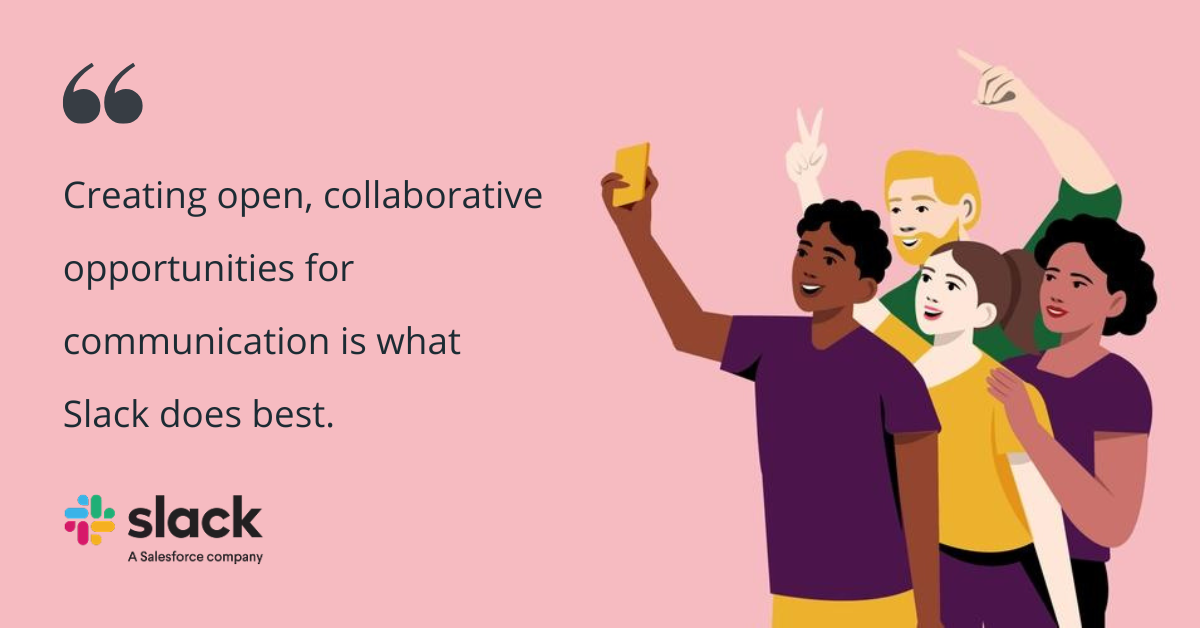Below is an article originally published on Slack's blog. Visit Slack's company page on PowerToFly to see their open positions and learn more.
More than 40% of workers considered leaving their jobs in 2021. And in the few months between spring and fall, more than 24 million employees in the U.S. actually left. That really adds up, costing U.S. businesses an estimated $1 trillion annually.
What drove that record-setting shift? According to the MIT Sloan Management Review, “toxic workplace culture” was the most critical factor. It was 10 times as powerful in predicting attrition in a company as salary or compensation. In one estimate, toxic workplace cultures cost American companies almost $50 billion a year in employee turnover.
Hiring and retaining employees is one of the foremost challenges for businesses, especially in a worker shortage. So how can companies attract and retain top talent? By intentionally cultivating a positive company culture.
What is company culture?
Company culture is a set of norms, values, characteristics, and assumptions. It includes the attitudes and behaviors of both employees and the company itself.
All companies have a culture. Some companies create a formal document to help leaders and employees create a particular, desired company culture. Netflix, for example, explicitly outlines what it values most as a company.
Company culture arises from people, policies, and behavior. Company leaders often have an outsize influence, but all employees influence company culture.
Why is it important?
Company culture matters because it is directly related to company success. Research consistently finds that some cultures influence key business performance metrics and:
- Engage employees better than others. Companies with engaged employees perform better and are more productive than those that don’t.
- Increase employee retention. Companies with high attrition rates spend considerably more on talent than those that don’t.
- Create psychological safety for employees. Employees who feel comfortable in their teams tend to be more productive.
Company culture may even be more critical to the effectiveness of teams than who’s on the teams. Google’s Project Aristotle found that team norms were much more significant predictors of effectiveness than the characteristics of team members. The key point is that company cultures can either foster or hinder company success.
What trends are emerging for 2022-2023?
Organizational culture is critical to success. To develop a thriving workplace culture, it’s helpful to understand how workplaces are changing. Here are the current trends in the future of work.
1. Inclusivity matters more than ever
There’s a strong business case for creating diverse, equitable, and inclusive workplaces: they tend to perform better. According to research by McKinsey & Company, the most diverse companies are more likely to outperform their less diverse counterparts in profitability by 36%.
But more than just better company performance, employees want inclusivity. In a recent survey by CNBC, nearly 80% of respondents said they “want to work for a company that values diversity, equity, and inclusion.” A survey by Glassdoor found the same thing: 76% of respondents agreed that a diverse workforce is “an important factor when evaluating companies and job offers.”
Creating inclusive, diverse workplace cultures is now a meaningful way to attract and retain talent.
2. Flexible work is increasingly mainstream
Flexible work was becoming common even before the pandemic. But Covid-19 made flexibility the surprising star of the conversation around workplace culture.
Companies shifted from entirely in-person work environments to completely remote work. Then they shifted again to a hybrid model. A recent Gallup poll suggests that hybrid work is now both the norm and the preferred working model for most employees. In the absence of another major shake-up, flexible work models are likely here to stay.
How a company works changes how it builds culture. Remote and hybrid working models can offer flexibility, increasing job satisfaction. But the lack of in-person interaction can take a toll on company culture, too. The challenge is for companies to continue to foster relationships among employees while they work from home.
3. Digital transformation will require organizational agility
If any aspect of work has changed as quickly as where we work, it’s how we work. The rate of change in digital transformation has been blisteringly fast. In a survey of more than 1,000 individuals across industries, the Business Agility Institute found that every respondent characterized their industry as “unpredictable and volatile.”
To stay competitive, companies are adopting new digital tools and ways of working on a massive scale. Foundry reports that 91% of companies have plans to digitize further. Global spending on digital transformation is predicted to reach $2.8 trillion by 2025.
Digital transformation is critical, but it doesn’t just happen. One of the most important factors in supporting digital transformation is having a digital-first culture, in which corporate culture embraces new technology.
4. Well-being as a key performance indicator
Among its other impacts, Covid-19 forced employers to pay attention to health. The pandemic had severe consequences for mental health, not just illness.
Wellness is directly tied to employee productivity. Research consistently shows that healthier employees are more productive and perform better. They also cost employers less.
Workplace culture can contribute to employee wellness. Some workplaces nurture well-being through comprehensive wellness programs, providing norms for healthy behaviors and encouraging employees to achieve work-life balance. Other workplaces overvalue constant work and create burnout.
How to foster a collaborative company culture with Slack
Company culture is influenced by communication. Creating open, collaborative opportunities for communication is what Slack does best. Here are some ways you can use Slack to support a positive company culture.
- Create an AMA (“ask me anything”) program. Let employees ask leaders anything in an open, inclusive Slack channel. It can help build rapport and trust. Invite participants to use emojis to vote for which questions to answer first.
- Embrace asynchronous video. Text is great, but asynchronous video can create intimacy and build relationships more effectively. For example, use it to recognize employees or post company announcements for employees to watch when it suits them.
- Create non-work channels. Provide your employees with a space to discuss their hobbies, interests, and home lives. These can help build relationships and create camaraderie.
- Use statuses to turn off from work. Employees can burn out if they feel like they are always “on.” Encourage them to use Slack statuses to let their team know when they’re unavailable.
- Keep track of employee sentiment. Slack offers several apps, like Culture Amp and Simple Poll, that let you take stock of how your teams are feeling. You can even make the poll anonymous. This can give you a snapshot of engagement and provide ideas about improving workplace culture.
Create a workplace culture that generates results
A workplace’s culture is critical to its success. Creating robust, supportive workplace cultures is key to attracting top talent, retaining employees, and providing the optimal conditions for them to be productive.
Building this kind of company culture can be challenging, but the right tools can help. Try Slack for free to learn more about how it can contribute to a vibrant workplace culture, or talk to Sales.




